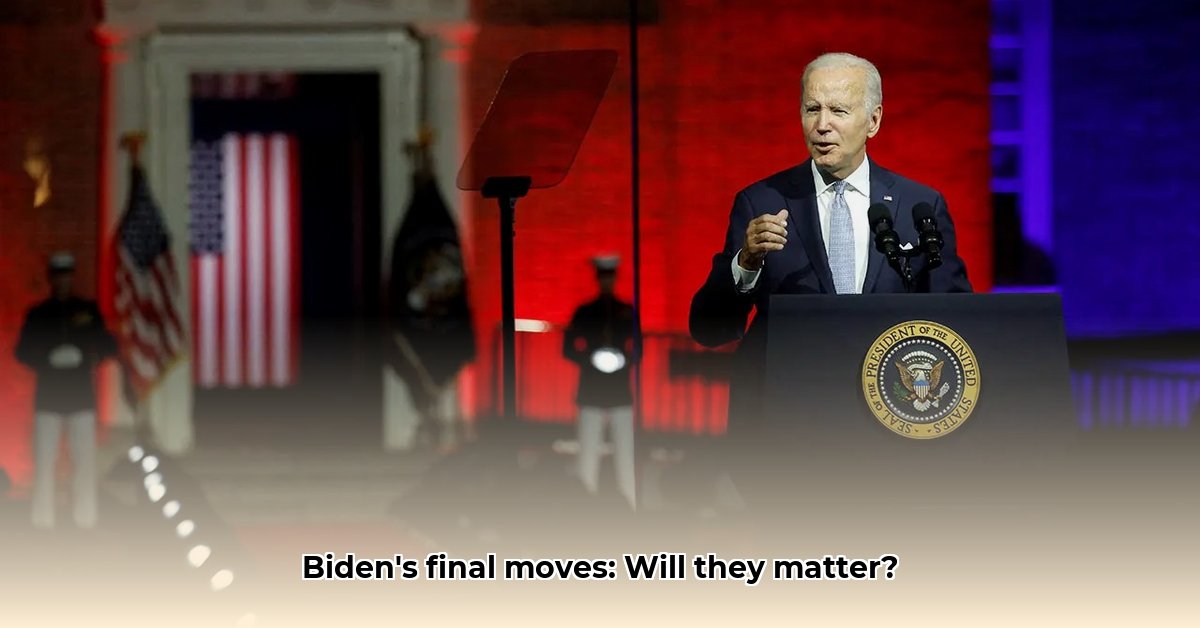With the end of President Biden’s term approaching and the transition to President Trump looming, a critical question arises: What can Biden realistically achieve in his remaining time? This article explores Biden’s potential actions, the challenges he faces, and the broader implications for American politics.
Biden’s Lame-Duck Agenda: A Race Against Time
As the clock ticks down, President Biden’s administration is in a race against time to implement policies and solidify its legacy. This period, often referred to as the “lame-duck” session, presents both opportunities and challenges. Can Biden maximize his impact before leaving office, or will political headwinds and legal hurdles limit his reach?
Executive Actions: The Primary Lever
Given the current political landscape, with divisions in Congress, Biden is likely to rely heavily on executive actions to advance his agenda. This approach allows him to bypass legislative gridlock and directly implement policies. However, executive orders are often subject to legal challenges and can be easily reversed by subsequent administrations.
Key Policy Areas: A Final Push
Biden’s final days are focused on several key areas:
1. Infrastructure Spending: The administration is working to expedite the disbursement of funds allocated to infrastructure projects, including roads, bridges, and broadband internet access. With billions already committed, these investments aim to create jobs, stimulate economic growth, and improve the nation’s infrastructure. However, bureaucratic delays and logistical challenges could hinder progress.
2. Climate Action: Biden is expected to take further action on climate change through executive orders and regulatory changes. These measures could include stricter emissions standards, investments in renewable energy, and protections for natural resources. However, these efforts could face legal challenges from industry groups and political opposition from those who prioritize fossil fuels.
3. Judicial Appointments: Filling judicial vacancies remains a priority for the Biden administration. By appointing judges who align with his legal philosophy, Biden hopes to shape the judiciary for years to come. However, securing Senate confirmation for his nominees could be difficult, especially if Republicans control the Senate.
4. Foreign Policy: Biden is likely to continue supporting Ukraine in its conflict with Russia, as well as addressing other foreign policy challenges. This could involve providing financial and military aid to Ukraine, imposing sanctions on Russia, and engaging in diplomatic efforts to resolve international disputes.
5. Immigration: The Biden administration may attempt to implement new immigration policies before leaving office. This could include measures to streamline the asylum process, protect undocumented immigrants, and address the root causes of migration. However, these efforts are likely to face strong opposition from Republicans, who favor stricter immigration enforcement.
Roadblocks Ahead: The Challenges
Biden faces significant challenges in achieving his goals during his final weeks in office. A divided Congress, potential legal challenges, and the possibility of policy reversals by a future administration all pose obstacles. The limited time remaining further intensifies the difficulty of making meaningful progress.
Potential Outcomes: A Legacy in the Balance
The potential outcomes of Biden’s final actions are varied. An optimistic scenario envisions significant progress on infrastructure, climate change, and judicial appointments, solidifying his legacy as a transformative president. A more pessimistic view suggests that his efforts may be stymied by legal challenges and political opposition, leaving his agenda incomplete.
Biden’s Legacy: The Final Chapter
The coming weeks will be crucial in shaping Biden’s legacy. His ability to navigate the political landscape, overcome legal hurdles, and achieve tangible results will determine how he is remembered by history. The final chapter of his presidency is still being written.
Legally Challenging Biden’s Executive Orders
Key Takeaways:
- Biden’s final actions include executive orders with aims to solidify progressive achievements, but face potential reversals.
- Executive orders can be challenged through filing a lawsuit, alleging harm, and raising constitutional or statutory grounds.
- Financial actions are harder to reverse, while regulatory changes and executive orders are vulnerable to political and legal challenges.
- Success in challenging executive orders requires legal representation, strategic legal arguments, and political maneuvering.
High Stakes: A Race Against Time
In the waning months of his presidency, Joe Biden is strategically employing executive actions and regulatory shifts to cement his policy agenda. However, the incoming administration threatens to dismantle these efforts, igniting potential legal battles.
What’s at Stake: Key Policy Areas
Biden’s legacy faces challenges across key policy areas:
- Infrastructure Spending: With substantial funds already allocated, reversing these investments would be complex and politically unpalatable.
- Environmental Regulations: While impactful, these regulations are vulnerable to legal challenges and swift reversals.
- Judicial Appointments: These appointments aim to influence the judiciary for decades, representing long-term investments.
Challenging the Orders: A Step-by-Step Guide
Challenging Biden’s executive orders involves a complex legal process:
- File a Lawsuit: Initiate a lawsuit in federal court, demonstrating a direct harm caused by the executive order.
- Legal Grounds: Argue that the order exceeds presidential authority, violates constitutional rights, or conflicts with existing statutes.
- Legal Process: Navigate a potentially lengthy legal process, balancing legal challenges with political and strategic maneuvering.
Biden’s Balancing Act: Risks and Rewards
Biden’s actions carry significant risks and potential rewards. Initiatives involving financial commitments have a higher chance of survival. However, regulatory adjustments and executive orders face intense political and legal scrutiny.
| Policy Area | Short-Term Impact (0-1 year) | Long-Term Impact (3-5 years) |
|---|---|---|
| Infrastructure Spending | High implementation; reversals may be difficult | Likely to endure; some projects could face delays |
| Environmental Regulations | Potential for immediate reversals | Substantial rollback; legal battles are anticipated |
| Judicial Appointments | Success dependent on confirmation timing | Long-lasting influence on judicial outcomes |
Successfully challenging an executive order requires skilled legal representation, strategic planning, and navigating intricate legal procedures. The process is lengthy, underscoring the test of endurance involved in the legal arena.
Biden’s Infrastructure Spending: A Last-Minute Push
Key Takeaways:
- Biden’s $1.6 trillion infrastructure plan faces time constraints with large amounts of unspent funds.
- Bureaucratic hurdles, complexities, and political opposition create obstacles to progress.
- Strategies to accelerate projects include streamlining processes, boosting awareness, and seeking bipartisan support.
- A potential change in administration poses a major risk to the plan’s completion.
- Success hinges on the ability to expedite spending, showcase progress, and unite diverse groups.
Racing Against Time: A Legacy on the Line
President Biden is under pressure to make a lasting infrastructure impact. Despite the plan’s wide publicity, billions remain unspent due to slow processes, raising questions about the administration’s execution.
Bottlenecks and Bureaucracy: Unpacking the Delays
Large-scale projects are inherently slow, involving extensive negotiations and procurement. The current pace raises concerns about efficiency. Are there underlying issues delaying progress?
Political Opposition: An Uphill Battle
Political factors complicate matters. Republicans closely scrutinize spending, creating obstacles. Can Biden garner sufficient support to advance his plans?
A Looming Threat: The Risk of Reversal
A change in administration poses the most significant risk, with unspent funds potentially diverted. Biden must secure tangible progress before a potential opponent takes over.
Last-Ditch Strategies: A Multi-Faceted Approach
Success requires a multi-pronged approach:
- Streamlining Bureaucracy: Expediting processes to accelerate project timelines.
- Highlighting Visible Projects: Focusing on projects with tangible results to showcase progress.
- Intensive Communication: Building public support by showcasing the benefits of infrastructure investments.
- Bipartisan Outreach: Seeking common ground with Republicans to foster cooperation.
Will this push succeed, or will these challenges continue to affect outcomes?
Potential Outcomes: Success or Unfulfilled Vision?
The final result is uncertain. The best outcome is accelerated spending and improved infrastructure. The worst case is unspent funds and a compromised vision. The coming months will be critical.
















